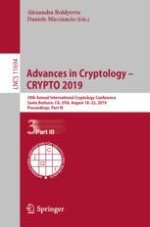2019 | OriginalPaper | Buchkapitel
Watermarking Public-Key Cryptographic Primitives
verfasst von : Rishab Goyal, Sam Kim, Nathan Manohar, Brent Waters, David J. Wu
Erschienen in: Advances in Cryptology – CRYPTO 2019
Aktivieren Sie unsere intelligente Suche, um passende Fachinhalte oder Patente zu finden.
Wählen Sie Textabschnitte aus um mit Künstlicher Intelligenz passenden Patente zu finden. powered by
Markieren Sie Textabschnitte, um KI-gestützt weitere passende Inhalte zu finden. powered by
